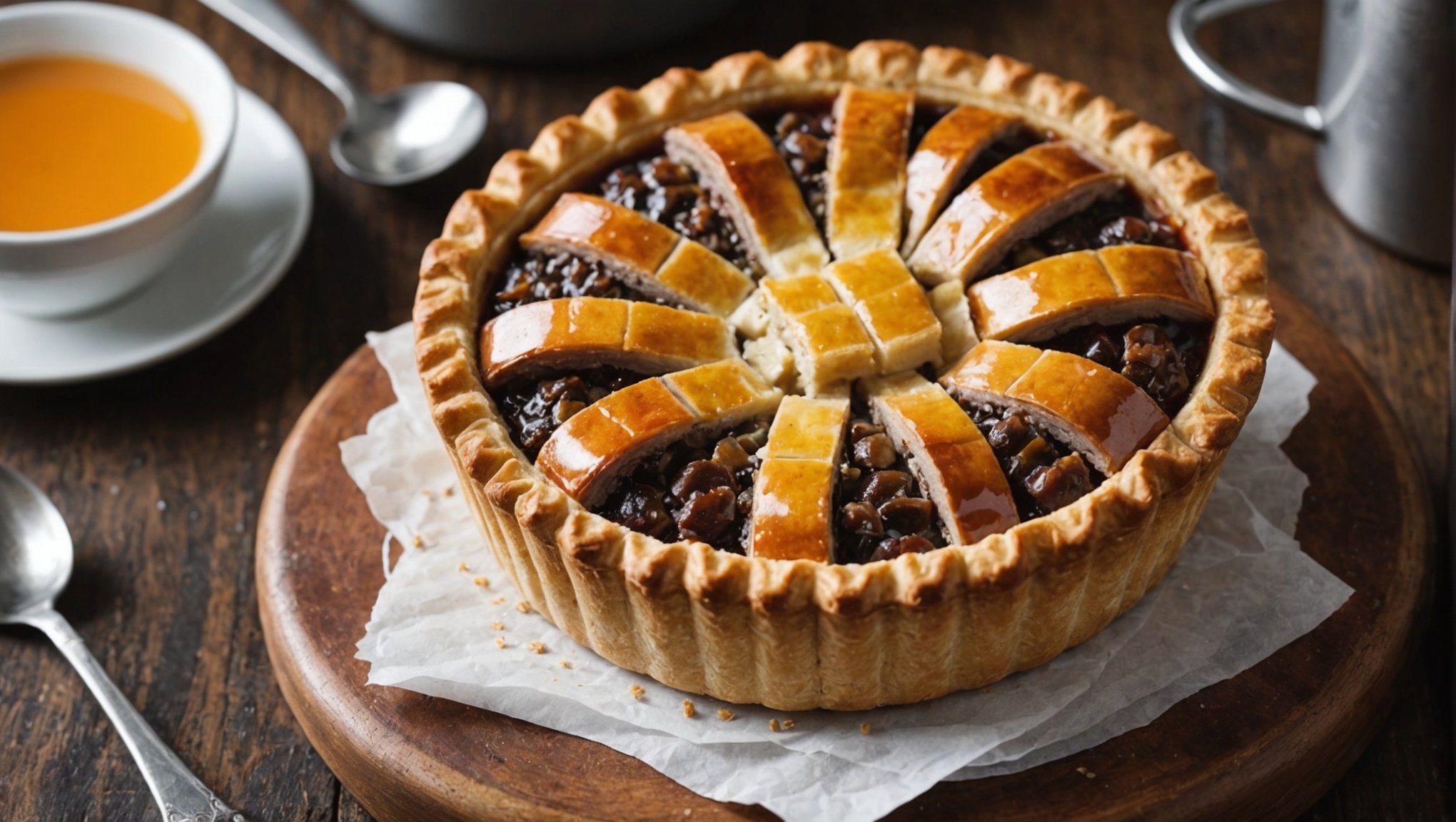Introduction to English Pork Pie
An English Pork Pie is a quintessential British dish with deep historical roots. Traditionally enjoyed as a hearty snack, these pies have become symbols of English culinary heritage. Originating in medieval times, pork pies were once luxury items reserved for the elite. Over centuries, they evolved into beloved staples of British cuisine, often associated with picnics, holidays, and festive gatherings.
At the heart of a classic English pork pie is the hot water crust pastry—an essential component that sets it apart from other pies. This unique pastry method involves boiling water and fat, typically lard, which is then mixed with flour to create a dough that is both pliable and robust. The hot water crust’s durability makes it ideal for encasing the savoury filling of seasoned pork.
In the same genre : Elevate Your Meal with a Zesty Thai Beef Salad drizzled in Lime Dressing!
Traditional recipes for English pork pies typically include pork shoulder and belly, seasoned with just the right amount of salt, pepper, and spices. The filling is encased by the resilient hot water crust, forming a pie that can endure transportation without losing its shape or flavour. These pies are typically served cold and often accompanied by mustard or piccalilli, providing a tantalising taste experience.
Hot Water Crust Pastry Technique
Making hot water crust pastry is simpler than it sounds. Begin with a mixture of plain flour, salt, and, occasionally, strong flour for added texture. The technique stands out by using boiling water and fat, usually lard or butter, melted together. This unique process creates a pliable dough ideal for robust pie shells that hold their shape.
Additional reading : Unveiling the Ultimate Tips for Creating Irresistibly Rich and Creamy Bread and Butter Pudding
To create your pastry, follow these step-by-step instructions:
- Boil the water and fat: Bring them to a boil simultaneously to ensure the fat melts thoroughly.
- Mix the dry ingredients: Combine flour and salt in a large bowl, forming a well in the centre.
- Pour the liquid: Gradually pour the boiling mixture into the well, stirring with a wooden spoon until a dough forms.
- Knead the dough: While warm, knead lightly until smooth, then let it cool to room temperature.
- Shape your pastry: Roll out the dough while it’s still warm, as it stiffens as it cools.
Avoid undercooking the pastry or adding too much flour, which can lead to a brittle texture. By properly following this recipe guide, achieving the perfect thickness and flavour is an attainable goal. With a bit of patience, this method can become your go-to for delicious, hearty pies.
Filling Options for Pork Pie
When crafting the perfect pork pie, attention to the filling is paramount. Traditionally, a pork pie filling focuses on seasoned pork, often a blend that includes pork shoulder for its richness and juiciness. This classic meat selection is at the heart of savoury recipes designed to highlight the flavour of the pork itself.
Enhancing Flavour with Herbs and Spices
For those interested in elevating the classic pork pie, consider incorporating herbs and spices. A sprinkle of sage or thyme can add depth, while a hint of nutmeg or white pepper provides warmth. These optional ingredients can transform a standard pork pie into a culinary delight, enhancing the natural taste of the meat.
Modern Takes on Traditional Fillings
As tastes evolve, so do the filling options. Exploring alternative fillings allows for a modern twist on an old favourite. Incorporate chicken or turkey for a lighter version, or add apples or apricots for a touch of sweetness. Vegetarian options, such as mushrooms or lentils, offer a contemporary take while maintaining the pie’s hearty texture. Such adaptations in savory recipes cater to diverse palates, keeping the beloved pork pie relevant and exciting.
Assembling the Pork Pie
When it comes to assembling a pork pie, precision is key to ensuring a mouth-watering result. Begin by preparing your chosen pie forms, which can range from traditional round tins to more creative shapes like rectangles or ovals. Each form can add a unique visual appeal to your pie.
First, roll out the pastry to a suitable thickness, ensuring it is neither too thin, which can result in leakage, nor too thick, which may overwhelm the filling. Line your pie form with the pastry, taking care to press it firmly against the edges. This step is crucial for maintaining the pie’s structure during baking.
Choosing the right molds and utilizing effective baking techniques can make all the difference. For example, using ceramic or metal molds can influence how evenly your pie bakes. Experiment with different materials to find which results best suit your taste.
For an attractive crust, brush the pastry lid with a beaten egg. This not only gives it a golden hue but also helps to seal the edges and prevent any filling from escaping. Properly crimping the edges is also essential. Consider a lattice pattern for a more visually enticing pie. With these tips, achieving a stunning and leak-free pork pie becomes a much more achievable task.
Baking the Perfect Pork Pie
Achieving perfection when baking a pork pie can seem challenging, but with the right cooking tips, you’ll master it. The temperature guide is crucial: preheat your oven to 180°C (350°F). This setting often provides the optimal balance needed for a golden, flaky crust without overcooking the filling.
Typically, a pork pie should bake for about 60-75 minutes. However, don’t just rely on time—watch for visual cues. As your pie bakes, check for a deep golden-brown crust and bubbling filling at the edges. These are strong indicators that reveal when the pie is properly done.
Avoiding common baking pitfalls is essential. To prevent a soggy bottom crust, place your pie on a preheated baking sheet. This helps in ensuring a crisp base. Also, brushing the top with an egg wash can aid in achieving an appealing golden hue and flavor.
Another tip: don’t skip on letting your pie cool in its tin for about 30 minutes. This allows the filling to set properly, making serving easier. By following these guidelines, you can confidently bake an impressive pork pie every time.
Serving Suggestions and Accompaniments
When it comes to enjoying a pork pie, the accompaniments are as crucial as the pie itself. Classic accompaniments like pickles and chutneys are staples in adding an extra layer of flavour. These tangy delights bring a sharp contrast to the rich taste of the pie, enhancing the overall eating experience.
For those who prefer something more substantial, consider the following ideas for side dishes. Cranberry sauce or a dollop of mustard offers a sweet or spicy kick, while coleslaw provides a refreshing crunch. A light salad, with fresh greens and vinaigrette, can also serve as a harmonious partner that won’t overpower the pork pie’s savoury richness.
The way you serve your pork pie can equally alter its flavour profile. Whether you decide to enjoy it warm or cold, both options have their merits. A warm pork pie releases an inviting aroma and offers a softer texture, while a cold serving allows for easier slicing and emphasises the pie’s dense and hearty nature.
Ultimately, pairing your pork pie with the right sides and temperature enhances the dining experience significantly, catering to varied palates and preferences.
Variations and Creative Twists
Exploring the world of pork pie variations opens up an exciting culinary adventure. Modern twists on this classic dish are captivating taste buds worldwide. To start, consider substituting the traditional pork with other meats like chicken, beef, or even game. Each offers a distinct flavour profile that can transform your pie into something truly extraordinary.
In addition to the meat, experimenting with creative recipes allows you to incorporate ingredients like spices, fruits, and exotic vegetables. Imagine infusing your pie with garlic, rosemary, or a hint of mustard for that extra zing, or adding a touch of sweetness with apples or dried fruits.
Utilizing seasonal ingredients not only enhances the taste of your pork pie but also celebrates the freshness of each season. Spring peas or summer berries can provide a unique twist, while autumn mushrooms or winter squash offer heartier options.
For those keen on crafting authentic yet innovative pork pies, here are a few tips:
- Select a mix of meats for a layered flavour experience.
- Season generously, adjusting spices according to the main ingredient.
- Balance textures by mixing crunchy and soft elements within the filling.
With a little creativity, the humble pork pie transforms into a canvas for unique flavours and recipes.
Troubleshooting Common Issues
Encountering difficulties while crafting the perfect pork pie is not uncommon. Understanding frequent baking problems can significantly enhance your cooking solutions.
A prevalent issue is the irksome soggy bottom crust. This occurs when the pie’s filling saturates the pastry during baking. To counter this, try pre-baking the crust or opting for a thicker pastry. Such strategies create a barrier against excess moisture, ensuring a flaky base.
Additionally, achieving even cooking throughout the pie can be tricky. Uneven heat distribution may result in a crust that’s overdone while the filling remains undercooked. To mitigate this, position your pie in the middle of the oven to promote balanced heat exposure. You can also rotate the pie halfway through the baking process.
Should you find the filling too moist, edge towards a thicker consistency by reducing liquid content or incorporating binders like breadcrumbs. These measures help maintain structural integrity during baking.
By identifying these typical pork pie troubleshooting scenarios and adopting these cooking solutions, you can enjoy a deliciously robust pie. Remember, practice makes perfect, so don’t hesitate to experiment and refine your technique over time. The solutions employed can transform your approach to pork pie perfection.
Visual Aids and Resources
Visual aids play a crucial role in understanding the cooking process, especially for those who learn best through observation. Watching recipe videos and studying visual guides can significantly bridge the gap between reading a recipe and actual execution. Whether you’re a novice cook or an expert looking to perfect your pork pie, these resources can be indispensable.
For visual learners, recipe videos are an excellent tool. They allow you to see every step in the process, from mixing ingredients to the final bake. Watching an expert’s technique ensures you understand how every action contributes to the end result. It eliminates the guesswork that often comes with text-only instructions. Various cooking channels and online platforms offer videos focused on crafting the perfect pork pie, an English classic, alongside detailed visual guides.
Furthermore, a plethora of resources is available online, offering both visuals and text explanations. These resources provide a more comprehensive understanding of pork pie recipes, giving you the confidence to tackle even the most intricate aspects of the dish. Engaging with these tools not only enhances your cooking skills but deepens your appreciation of culinary traditions.











